Damian put up three signs above the cat’s feeding station. They read, from left to right: “No breakfast,” “No lunch,” and “Dinner okay.” So now the cats won’t ask for food unless they are on our schedule. The only problem for the rest of us is that they are written in cat language. The cats (and Damian) can read them.
Jon Katz, in his book The New Work of Dogs, talks about how we anthropomorphize animals, particularly dogs, and the consequences of this. After reading the book, I think (hope) I have a better understanding of what it means to relate to animals. Katz’s book is one of the best—well written, seamless, interesting, perceptive, engrossing and instructive. Dogs, who once were mainly work animals—herding, hunting, protecting—are now bred to be companions. And not just dog companions, but pals, friends, best friends, compassionate and understanding. In the many examples he gives in the book, dogs become surrogate people. As he says:
The range of dogs’ work these days is breathtaking: they join search-and-rescue missions, help the blind, guard property, sniff for bombs and illegal drugs, and comfort the elderly, the traumatized, the bereaved, and the lonely. Therapists enthusiastically enlist dogs in treating drug and alcohol addiction and in a broad range of rehabilitation work. They increasingly use dogs to help emotionally disturbed children.If there is a cloud hanging over this work, it’s that the fate of these animals is so varied, the results so difficult to measure , their work so often unrewarded.
Many dog owners today live in much closer emotional proximity to their pets than in previous generations. Dogs are often used to fill emotional needs, to help their lonely, needy, discontented and disconnected owners. Katz tells the stories of people he spent time with to observe their relationships with their dogs—from single woman looking for companionship; divorced women gathering (with their dogs) to support each other; men walking their dogs together at 5 am, before going into the city for work; children given a dog they didn’t want as a present, then later abandoning the dog; a boy who used his dog to intimidate his peers, give him status in a rough neighborhood; a woman who has dedicated her life to rescuing dogs from shelters, finding homes for them, while ignoring her own (grown) children; another woman dying of cancer; a man alone in his old age. In all these situations, the dogs were used by their owners and the dogs responded. They sensed what was expected of them and they worked for their owners.
Yet Katz feels that we often know little about dogs and want to learn less.
If we really knew dogs, would we be attributing to them the vast, complex panoply of emotions that are unique to humans? See them as people when they are not? Would we overfeed and underwork them? Would we acquire large, active working dogs for small apartments or town houses in congested tracts? Would we refuse to train them? Beat and abandon them by the millions? Would we bar them from doing almost everything they naturally want and need to do, from roaming and sniffing to settling dog scores and chasing squirrels?
The book is mainly the fascinating stories he tells about the people he came to know and their relationships to their dogs. What becomes clear is the need for appropriate training of the dog. Your (and my) dog may be brilliant and talented, but she is not human. Dog’s are animals and need to be treated accordingly. Katz also says
Shouldn’t there be groups obsessed with helping abandoned people, helping to replace their mobile children or deceased spouses, repairing the damage left by their unhappy childhoods, making them whole and happy? Rescuers could screen their new lovers and partners, check on friends to ensure that they were loyal and wise, visit their charges’ new homes to be sure they were properly cared for.Give dogs their bittersweet due: they’re doing hard and sometimes thankless work. But that says something about us, something that doesn’t often show up in media stories, glossy pet magazines, or picturesque slow-motion dog-food ads. . . . Often, if you scratched a dog lover, you found some underlying pain, something that opens a vein of empathy, nurturing, and affection. It’s the part of the human-dog experience that draws me most as a writer.
And I am now deeply immersed in another of his books: Katz on Dogs, more of a training manual but including as well many of his helpful and beautifully told tales of dogs and their owners.
Like standing on a dock ready to jump in—to the waters of the past yet being in the present—the last couple of days have been invigorating—creating new memories. When we were in the (very large, crowded) dim sum restaurant in Chinatown yesterday, around a (very large) round table seating all eight of us (Tamar, Dan, Damian, Jessica, Aaron, Myself, and Leah & Pedro—friends from when we lived in SoHo), Leah turned to me (after surveying the group) and said: “Now we are the old people!”
When we met first Leah and Pedro, Tamar, Aaron and I had moved into a rental loft in a co-op building on Spring Street. The neighborhood was still young—few shops, long walks to buy groceries, and some factories still functioning. And we (the “adults”) were still young—in our early thirties. After leaving my marriage and nine years in a (very) large apartment on West End Avenue, I had first moved with my two children, two cats, two fish tanks and lots of art supplies, to 13th and First Avenue—a sublet that had at one time been used as Claus Oldenburg’s studio. Patty Oldenburg lived next door with a big black cat. We moved in with two Siamese. A few months later we had nine black kittens. It was a fourth floor walkup (with high ceilings in the lofts) and I remember carrying bags of cat food up the (many) stairs for a few weeks. As well, the painter Larry Rivers lived upstairs. There was no insulation between the floors and when he came home at four in the morning, with friends, wearing cowboy boots, we were all awake. I got back at him by playing children’s records in the morning.
On Spring Street, my upstairs neighbors were also playful and I was curious. One day I met Leah in the elevator. She invited me to come up for coffee. From then on we were good friends. Besides the dinner and dance parties, trips to galleries and movies, Leah and I used to henna each other’s hair. There were six lively people and two dogs living in their loft at that time. I got my first dog, Miranda, while we lived there. Then we moved to Broome Street—a loft that became co-op and gave me the resources to move then to Nova Scotia.
So in the past couple of (very intense) days—seeing Manhattan from the point of the where we have lived and who we know there, we’ve visited some of the most important people in our lives here. Our first stop, on Wednesday, was Aaron’s best friend, Gillie, and her mother from when he was nine months old until we moved away from Manhattan. We met in Riverside Park and the children, even as young as they were, became good friends immediately. The two children went to Ireland together when they were nine. Gillie’s dad still lives there. We were all very close and helped each other in those early, painful post-divorce days. I have stayed with Harriet often over the past twenty plus years on my visits here. When we left, we poked our heads into the lobby of the building we had lived in on West End Avenue. It has become a co-op and been upgraded, enhanced. From there, my children visited with their father for a couple of hours while I visited a friend (whom I also met through Aaron when he was nine years old). Then we all gathered together again before returning to Montclair to get some sleep before beginning a second day of visiting the past.
Yesterday after enjoying the dim sum and the friends, we went to Leah and Pedro’s loft. They still live on Spring Street. Walking into the building was replete with memories for my children. I have stayed there too on my visits to NYC so I was aware of the changes—new elevator, nicely painted and restored lobby, beautiful front doors. On leaving, we also passed by where we lived on Broome Street, another place that has been upgraded. When we lived there, we had an antique elevator that serviced only our floor (the top) and held about two people and a dog, an intricate metal cage that operated by pull cords. It had caught on fire when being serviced and was removed after we left. Broome Street was still Boom Street to us—very noisy and possibly even more clogged with traffic to the Holland Tunnel.
Then we went for dinner with my sister’s son, Rob, who is now living and working in Manhattan. He’s two years and one day younger than Tamar. It is always a delight to get together with him. He’s working in an architectural firm and painting in his (hopefully more) free time. So we had a lot to talk about—family, work, travels.
And from there we returned from our trip down memory lane. Today we will be happy to stay here in Montclair.
Today is Tamar’s birthday. Forty-four years ago, after a fitful night, I stumbled to the car, was whisked to Walter Reed Hospital in Washington, D.C., and gave birth a few hours later to a beautiful baby girl who has now become a beautiful woman with a rewarding family of her own. This is the first time in many years I have been able to be with her on her birthday. After one winter storm several years ago delayed my return trip to Nova Scotia from LA, I’ve been traveling home before New Year’s, trying to beat the weather. So this year, with her being so close—only one plane ride away—I decided to be daring and stay for the new year celebration in Montclair, with a major bonus of being here on her birthday.
On her fortieth birthday, I was doing a solitary retreat (one that happened to be a very difficult one) for three weeks. But I felt it was important (irregardless of protocol!) to call Tamar on her birthday. After that, the last few days were much easier. Family is very important to me and I have been blessed with two wonderful human beings as my children. I am always grateful for their presence in my life.
Today we are going to Chinatown for dim sum. It’s been a tradition for Tamar & Co. for several years. This time we will be in Manhattan, joined by Aaron & Jessica and some friends from our SoHo days. It continues to be a couple of days of connecting to the past and laying a path for living in new places with new and old friends.
I think we often feel that our birthday, the way we spend it, how we feel, how people treat us, is a marker for how the next year will be. Happy birthday, Tamar! I hope all your wishes and dreams are fulfilled.
None of us felt like doing much today. Too many late nights and early mornings for all of us for various reasons—school, work, friends, talk. So we took a walk in Mills Reservation where all the dog owners go. I’ve been reading about the Montclair people and their dogs in The New Work of Dogs by Jon Katz (one of the books Tamar gave me). It’s an amazing book that I will talk about more when I am finished—very soon. And we did see many dogs and their owners—right out of the book! As we walked along the paths of the idyllic wooded reservation, Tamar took many many many pictures. She has a new upbeat, happy camera and is in love. (I have lots of pix in my camera but neglected to bring my card reader or cable so they will have to wait until I return home.)
Tomorrow we go into Manhattan to visit with old friends and see the city, show Jessica our old home, the places we’ve lived and things we remember, and of course, take more pictures. That will be interesting.
Now that the Merry MishMash is over (gifts here in the morning and dinner and an evening of gifts and gab at Dan’s parents, all enjoyable in its holiday kind of way), the merries and happies have really begun. After sitting two and a half hours on the tarmac in Montreal (because of freezing rain, a lineup for the de-icing bay and runway backups), Aaron and Jessica arrived this afternoon. This is the first time in Three and a Half Years that We have All Been Together. This is my Family. And I am a very Happy Camper!
So far, we haven’t stopped talking, catching up, getting to know each other in new ways. It’s going to be a very busy four days, touring Montclair (a lovely town that reminds us all of various places we have lived—Halifax, Great Barrington—only nicer, more beautiful big houses, more interesting shopping areas with small stores and intriguing restaurants), going into Manhattan to taste the past and the changes that have happened since we all lived here and also to visit with friends. There are not enough hours in the day or days in this week!
Following Tiny Coconut’s lead, I am posting a list of (most of the) books I have read this year. I’ve tried to list them in descending order of enjoyment, but that is impossible without also describing why I like (or dislike) a book. I don’t think it’s exactly justified to say that some of these books are better than others. Some are just different. And some are really not good. (Most of them I have written about in other parts of my blog, so I will just say a few words.) . . . . . . .
Lost in the Forest by Sue Miller. A perfect book.
Light on Snow by Anita Shreve. A winner. Her best.
An Invisible Sign of My Own by Aimee Bender. A very beautiful, sensitive book.
All That Matters by Wayson Choy. Another wonderful story by Choy. About Chinese immigrants in Vancouver during The War. His other book I had read previously, The Jade Peony, is also a great book, the same story told from the sister’s viewpoint.
How Dogs Think by Stanley Coren. Well, need I say more! A great book! Probably what started me on the puppy path.
To the Wedding by John Berger. A poetic, tender, moist story of transcendent love and loss.
While I Was Gone by Sue Miller. A disappointment to me but a favorite of many of my friends.
The Lady and the Unicorn by Tracy Chevalier. Interesting; a sketchy romance woven around medieval tapestry making. I read it on the plane going to Europe, which made it more intriguing.
Tales of Protection by Erik Fosnes Hansen�s. Four interesting stories with a complex link.
I Married a Communist by Philip Roth�. Slow to start (for me, who is not usually able to read political stories) but increasingly fascinating, about obsession in love and politics.
Blink by Malcolm Gladwell. I kept referring to this one in conversations and while teaching. It’s a good one.
Dress Your Family in Corduroy and Denim by David Sedaris. A very good, humorous memoir. About his dysfunctional family. He leaves no one out of his witty assessments of behavior, including himself and his partner.
Wait Till Next Year: A Memoir by Doris Kearns Goodwin. I really enjoyed this tale of baseball mania. It felt like a journey back to my childhood, when the World Series pre-empted classroom studies and we listened to baseball games in school.
The Confessions of Max Tivoli by Andrew Sean Greer�. Another very interesting book, much better than I would have expected from the “idea” the book was formed around, a man living his life (physically but not emotionally) backwards, from an old man at birth to a baby at death.
Cause Celeb by Helen Fielding. A more serious book than I expected. The humor was weak but the content, message of the book was excellent. It’s a story about a woman whose dysfunctional relationships leads her to relate to human suffering in the refugee camps in Africa.
Richard Wright’s novel Adultery. Not very good. I was glad to finish it, although the story had great potential.
All He Ever Wanted by Anita Shreve�. Not a favorite book. I love most of Anita Shreve’s writing, but not this one.
The Shadow of the Wind by Carlos Ruiz Zafon. A dense gothic mystery novel, an intriguing story but either poorly written or poorly translated. It did improve as it moved along its intricate storyline but I am not sure I came out of it any wiser.
Never Let You Go by Kazuo Ishiguro. This was one book I actually put down. Even though recommended by two favorite reader friends, it didn’t catch my interest at all.
And believe it or not, I read The Da Vinci Code by Dan Brown. A very poorly written book. Not one surprise in it. Trite dialogue. But because of all the hype, and because I do know people who feel there is some accuracy in the storyline, I’m glad I read it. So I now know what people are talking about. But no more than that.
And then there are the dog training books I am currently enjoying, ones I need to read and reread:
The Art of Raising Your Puppy by The Monks of New Skete
How to Be Your Dog’s Best Friend by The Monks of New Skete
Dog Training for Dummies by Jack Volhard and Wendy Volhard
Puppies for Dummies by Sarah Hodgson. (I read this one in the bookstore so then) Tamar gave me the following three books:
Puppy Perfect by Sarah Hodgson
Katz on Dogs by Jon Katz (who lives in Montclair, New Jersey)
The New Work of Dogs by Jon Katz. Much more on this fascinating book later.
So that’s it for 2005. I don’t for a minute think reading has been injured by the technology revolution. Most of my friends are intensive readers; the library is full every time I go there; lots of my students read serious literature during breaks at school and there are a lot more good books out there waiting to be read. Just as gyms (exercise for the body) are sprouting up everywhere, people need to read: exercise for the mind.
With all the “excitement” in my daily life lately, I seem to have missed the two-year anniversary of my blog. Two years ago, on December 18, 2003, visiting Tamar in Los Angeles, she helped me set this up and since then it’s been an interesting exploration of thoughts, feelings, places and people. Although my work needs an audience (paintings have no life if they are not seen), I was never a very public person and I have surprised myself with the pleasure I have felt in putting my experiences out there, revealing the meanderings of my mind, not even knowing about where “there” is. And I have surprised myself even further by starting another blog, one that is only about my experience in my studio. I’ve never been a steady “personal journal” keeper just like I never kept a sketchbook. (Well, I did as a young teenager and it hurts to read what I wrote in those tender years.) I love writing letters, knowing that someone would read it, that I am passing “information” along. Email is a delight for me: easy to write and send (no envelope to find, write out, icky glue to lick, no stamp to locate, use). Just write, click and send. Although a “little” more complicated, a blog is similar, for me, to writing letters. It is communication; I feel like I am talking to “someone.” So maybe that’s why I enjoy it.
And now Tamar is stopping, for a while, after six years of (almost) steady writing on line, making many lasting friends, trying out different ideas and approaches. It will seem strange not to log on to her writings but we do (I must admit) tie up the phone lines frequently. I will miss her writing in her blog.
Holidays are madness. I don’t know why we have them. Well, really, I do. And really, we need them. We need time away from our daily tasks, away from work, time to be with friends and family, time to play. But holidays can very easily turn into madness.
Yesterday afternoon, while standing in the grocery store, at the deli counter, I overheard a man irately telling another man: “Some people have a lot of nerve, butting in. They should wait their turn like everyone else.” He claimed he’d been there first and the other man said simply: “No you weren’t” and calmly proceeded with his order. The first man replied something to the effect of: “Get out of my face!”
Then a woman near me said she needed to get to some items just behind me. “Get out of my face,” she joked. “Happy holidays,” said I, as we both laughed.
So now I am safely (and happily) ensconced in Tamar’s beautiful home in Montclair, New Jersey. It took very little time to get to know where things are—where the glasses are kept, the silverware, where to put my clothes and toiletries, how to keep my bedding out of everyday sight (I’m camping on a very comfortable living room couch and the main floor being all one room, it is important to keep it clear in the daytime). I get to walk with Tamar and Damian in the morning to the school bus stop, meet the other mothers, walk back up their steep hill, go back again to meet the bus in the afternoon, enjoy the pleasures of being a grandmother. Damian has grown incredibly in the past year. Tall and lanky, smart, capable and feisty as usual. I like it here.
Yesterday I went into Manhattan. The atmosphere was rushed, but leisurely as well—people walking who would have taken the bus or subway. (The strike was settled while I was there and the trains are running again this morning.) Shops were empty. Not many non-Manhattanites were traveling into the city. I wasn’t there to shop.
First I had a tango lesson with the magical Rebecca Shulman of Dance Manhattan. I had seen an instructional video she had done with Daniel Trenner and was mesmerized by her bearing and her footwork. She taught me about embellishments: what I need to enjoy the dance even more. The dancing experience with Rebecca pulled me out of my somber mood, helped me to realize that I am very much alive. It’s hard to say this without feeling I am trivializing or dramatizing my feelings. My grief for Robert is very real, but I can still enjoy my life as it is now. He is still very much a part of my life, my history, and always will be. Nothing can change that. I have been surprised by the depth of my feelings for him. It was hard coming back from Rhode Island after visiting him. It is hard to talk about being upset about something but still being able to enjoy life. But I do think I have a better perspective now—on all of it.
After dancing, I went to visit my friend Lynn. We have known each other since our sons were nine, both at P.S. 3. They became friends; we became friends. We had dinner in Gobo, a great restaurant where we often meet on my visits here. Hardly anyone was there. The transit strike had definitely affected businesses. We talked about the past, the present, things we’ve shared, places and people, new things in our lives. And aspirations for the future.
While sitting there with Lynn, I could easily understand how Tamar wanted to come back here. To her roots. I have roots here too. It feels good to be with old friends, to be with someone I’ve known for a long time. We’ve both changed; we’ve had some rifts; we still understand and appreciate and enjoy each other. And I have other friends in the city. But I know I am still, at heart, a country girl. And it will be fine to go back to Nova Scotia and the big change about to come into my life: my pup—my new companion, a warm body in my house.
I went to visit Robert yesterday. I went with his friend Jim. We took the train from Penn Station to Providence. Neither of us felt up to driving but in the end, Jim kept saying he wished he had rented a car, then we could have stayed longer, wouldn’t have been dependent on Cynthia to drive us around, could have done more to help Bob clean up his belongings.
Cynthia met us at the train station, shuttled us from there to the nursing home, to a restaurant for lunch, to Bob’s apartment, back to the nursing home, back to the train station. She is a tireless, generous, insightful, compassionate person and I (as well as Jim and Bob) am so grateful to her and her agency, Access. She said that Bob has talked about me often during the five years he has been in her care. I’ve been very much a part of his daily life. This helped to hear.
She asked us both if we were shocked by seeing him as he is now—pale, immobile, a white beard (no one had shaved him for a few days, maybe because they knew he might yell at them if they didn’t do a good job), and slightly groggy from the pain medications. Both of us had expected worse. He was still Bob. Still fretting over details of his care, his belongings, not wanting to be a burden, but not being able to do anything for himself. Not able to feed himself, take a sip of water by himself, not even able to ring for a nurse himself, hold a phone, change the TV channel, comb his hair, wipe a tear away. And having been a very independent, resourceful person, this is a very difficult situation for him to be in. And being a very demanding, impatient person, this is hard for some of the people taking care of him.
He was glad to see us. Being a captive, immobile (impatient) person (stuck here all the time, he said), we were a welcome addition to his day. Bob has begun eating again. Sunday they served pizza and Bob wanted some. It was good. The first time he had eaten since Thanksgiving. So Jim had brought a tiramisu cake from Fennelli’s. And the meals served him were good. I was happy to feed him.
Finally, towards the end of the day, both Jim and Cynthia left the room and gave me time alone with Bob. It was a wonderful, peaceful time. I massaged his head and neck. We didn’t talk much but there was profound communication. The unspoken, important, lasting kind. And before leaving, we kissed and I caressed his face and told him I love him. He smiled. A proper good-bye.
On the train ride home, Jim and I talked about Bob’s condition, how hard it is to see him, how sad, what an amazing person Bob is and how little luck (as Jim put it) Bob had in his life. How difficult everything was for him and how difficult he was as a person. And how brilliant and enjoyable he could be. Jim also said he didn’t think he could have lived knowing the prognosis. I don’t feel that way. I think facing death is a heightened and immediate part of life: it gives you the opportunity to make amends. It’s like opening a door to a cluttered closet and you can see what you need to clean up, sort out, purify. Death is inevitable for all of us. You have to do it anyway, so you might as well do a good job of it. I know that those last moments with Bob were priceless for me. In many ways, the intervention of the antibiotics, which prolonged his life for (maybe) a couple of more weeks, was a blessing. It gave everyone involved in his life, and hopefully himself, a chance to be more available to his life and death process.
I have an aunt who was paralyzed from the neck down at twenty-one. She was stricken with polio, lived for twenty-five years in an iron lung and she said often she didn’t want anyone to feel sorry for her. She lived a full, generous, rewarding life, enjoying herself and helping others. She was a powerful, self-directed person. She made a beautiful life from adversity. So yes, I think it is possible to take an illness and make it a learning, growing, beneficial experience.
Bob is mostly concerned that there not be too much pain when the time comes. Cynthia is making sure that this will not happen. I came home with some books and CD’s he wanted me to have. It is unlikely he will live more than a week or two longer. But I am so glad he is in such good care and that I had a chance to spend some time with him now.
So it’s off to below the 49th parallel. My bag is packed and my house is clean. It always amazes me how much cleaner the house is when I leave it than when I live in it! What am I cleaning for: the dust bunnies who will conference here while I am gone? But I must say, it will be oh so nice to come home to a clean house. I’ve been too busy lately to put all those papers that pile up into a better place than my horizontal file—the dining room table and chairs. I always prefer to paint than clean. But there comes a point when I am grateful for a day set aside for making amends with clutter.
I’m looking forward to seeing Tamar, Dan and Damian in just a few hours! It’s been long enough.
There seem to be only two main thoughts in my mind these days: Robert and my puppy. Meanwhile I go about my daily tasks, prepare to leave for two weeks, even paint some, sew, clean house (more or less), read, enjoy friends and very much look forward to being with my children. School is finished for the semester, grades are in; I’m free for three weeks. Just me. Me and my family and friends.
Meanwhile, I give you one more interesting section from How Dogs Think. It’s about anthropomorphism. As described by Stanley Coren anthropomorphism is rooted in the human “ability to use knowledge about our own behaviors and feelings to try to understand and anticipate the behavior of others.” He continues: “Viewing the world and estimating the reactions of others based upon the assumption that they act and think like we do is not unique to people. I have often heard people say, ‘My dog thinks that he’s a person.’ This is not true. The dog really thinks that we humans are dogs. We may be strange-looking dogs who walk upright instead of on four paws, and we might not be very bright dogs, since we don’t respond or engage in the full spectrum of canine behaviors, but we certainly act enough like dogs so that they can get along with us by assuming that we will react and respond like dogs.”
So it makes me think about those long hot days of August, the ones we call dog days. Because we think they are for lazing around, like a dog. But actually, it’s that Cirrus, the dog constellation, is high in the sky. Or people who misbehave, the ones we don’t like and call a “dog.” Or the expression, “Dog gone it!” That’s a strange one. From a dog’s point of view, we’d better shape up quick!
And in three weeks my whole life will revolve around that point of view as I turn into an Alpha Dog. Woof!
I haven’t yet figured out what makes you love someone and not another. Someone plays music with your heartstrings; by another it is cacophony, dissonance. I have spoken to Cynthia who is the main caregiver for my friend Robert. She says he is doing well, back in the nursing home, alert, not eating, and preparing to die. He is also eager to see me, as I am to see him. I’m off to New Jersey on Sunday to visit with Tamar & Co. for two weeks. Aaron and Jessica are coming down from Montreal for a few days after Christmas. But first I will take a trip to Rhode Island to visit Robert, to say a proper good bye.
Tamar and Aaron will be visiting their father who is also not well. If he wished, I’d be happy to see him. I probably won’t see him. Maybe I will. I don’t know. But I feel more resolved with him at this point. We made two beautiful children and that’s very important. That’s enough for me.
Taoist saying: Number seventy-four. If you understand that all things change, constantly change, there is nothing you will hold on to, all things change. If you aren’t afraid of dying, there is nothing you can’t do.
I’m still fascinated by passages I read in Stanley Coren’s, How Dogs Think. I finished the book, finally, after having interspersed about a half dozen other books during the process. (This one being so dense and interesting, I’ve savored it slowly). He has a section in the book titled “The Social Brain.” Dogs are pack animals, and so it seems, are humans. He describes the “Social Brain Hypothesis” which says that “one of the major reasons intelligence evolved and became more complex in the first place was that it was designed to solve social problems. The more complex the social organization in which an animal lives, the more intelligence he needs and the more his brain is oriented toward social issues. Humans, of course, are social animals and spend most of their time exchanging personal and social information.”
Coren goes on to say two British psychologists sampled conversations and found that “more than two-thirds of our conversations are taken up with social and emotional matters. Typical topics dealt with who is doing what and with whom, and perhaps commentaries on whether that is a good or bad thing. Other topics include who is a moving up in the world and who is moving down and why.”
In a study that Coren conducted, monitoring over a hundred discussions between his colleagues at the university where he teaches he “never found a technical discussion that went on for more than seven minutes without lapsing, at least for a while, back into social conversation. In fact, only about one-quarter of the time was spent on technical matters overall.”
Leaves one pondering. As my mother used to say: apple pie without the cheese is like a kiss without the squeeze.
One of the (many) things I am realizing through the process of losing my friend Robert is that it is okay to feel, to have whatever feelings you have. When I was sixteen, my uncle Harold died. He had lived with us for a while. I was very fond of him. I loved him. He gave me a royal blue cashmere sweater for my sixteenth birthday. He taught me to play chess; he took me out to dinner; he was a loving uncle. He served in China during World War II and it seemed to have broken his spirit. He was only thirty-seven when he died of a heart attack. My parents didn’t tell my sister. She was at University and they didn’t want to upset her. I learned early that grief was “upsetting.” It was not okay.
I was interested in the books Tamar is reading to Damian, the one’s that describe life as it really is, with all the difficulties, the darder side of human nature, laid out along with the beauty of human enterprise. I had to be an hour late today (it was planned because of a previously made appointment) to a painting class I teach to a small group of adults. Apparently they had had trouble getting started without me there giving directions. I had told them to set up their own project to paint. When I walked in, they said how hard it was, they were missing something. “The motivating factor,” I said. I also said that’s what it’s all about, the rest of your artistic life, making decisions about what to do. In painting, as in life, so much of the time the experience is groundless, open to so many possibilities. Being tuned in (and not holding on too tight) to what is actually happening with each brush stroke, letting them happen, that’s what it is all about. My Buddhist teacher, Chogyam Trungpa, Rinpoche used to say it is like walking a tight rope holding a spoonful of water.
On a happier (happy/happiest) note, I visited my puppy yesterday. She's one month old now. Jane, the breeder, told me that everyone who sees her asks: "Who's gettting that one!" She's a perfect puppy: friendly, sweet, and very beautiful. She comes home with me in three weeks. It couldn't be better timing.
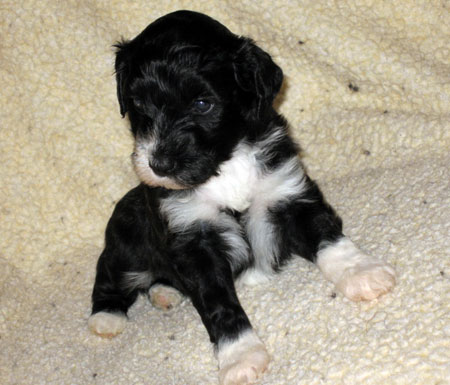
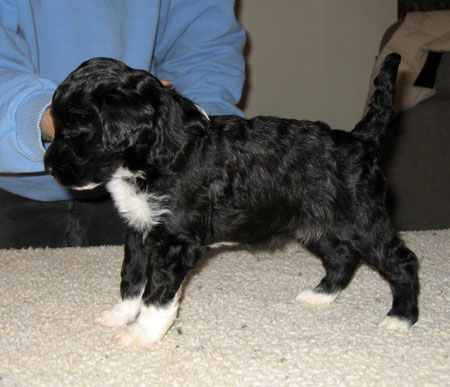
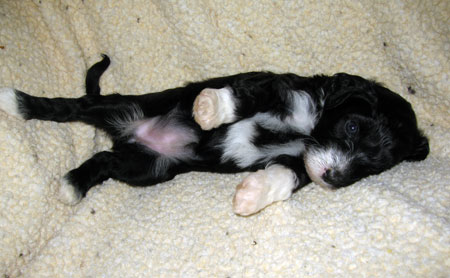
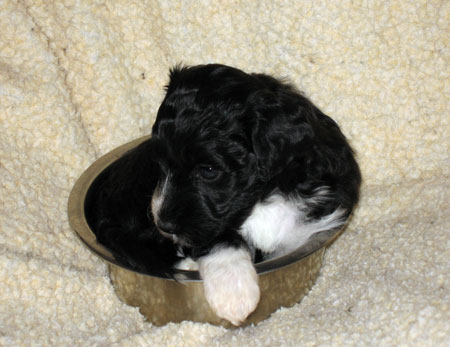
First, there is a pumpkin to carve:
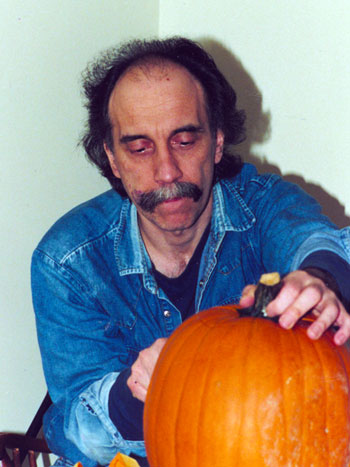
Then winter comes and there are snowballs to make:
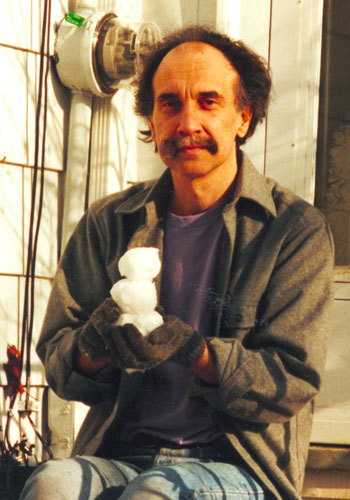
And throw: So you want to take my picture, eh!?!
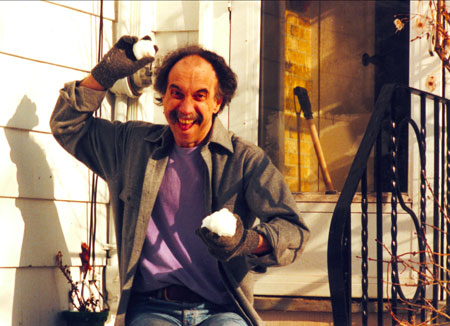
Aw, let’s kiss and make up!
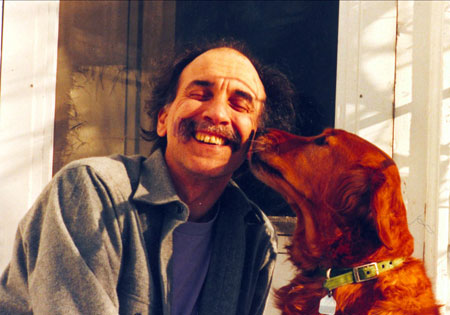
Bob used to say Katie was Scotch Guarded. The water ran off her back, didn’t penetrate her fur, but she was still hurt by words.
We were living in a wretched little house in Seabright at the time. The basement flooded every week. I had to ShopVac it weekly to keep the mold down. It was a losing battle so we then moved into Halifax for a year where I stayed three more years until I built the house I am in now. This house has lots of stairs, perhaps a way to keep me from inviting Bob back. Besides, I do like stairs, separate levels for separate activities.
There's been no more news yet. So now, I’m off to visit my puppy. My soon-to-be new playmate.
It was raining hard today. Eight degrees centigrade. Flooding the streets in Halifax. And they say it will be minus ten by Thursday. After the recent news of my friend Robert’s imminent death and the heavy snow a couple of days ago, this feels right. Fickle, difficult, sad.
I found myself drifting into “what if” scenarios all day. What if I had, as a friend suggested, taken Robert’s insults like water off a duck’s back, what if I had been different with him, what if I was someone else, what if he had learned from his anger earlier. Those poisonous thoughts, the "what if's," that keep you locked in the past.
He did try to make amends recently. He was being very nice. We had some good, gentle conversations. Ironically, he wanted to buy me a generator. It would have helped Saturday when the power failed. But it never happened (because of government regulations on how he used his money, being on disability and assistance). At least he knew that he had caused me much unnecessary pain. That in itself helps me. Helps him.
I once titled a painting: “What If the Moon Were Blue?” My university logic professor would always use the image “what if the moon were made of bleu cheese?” when talking about probabilities. If the moon were blue, then life would be different. If it were made of bleu cheese, the astronauts landing there would have had a very different experience. Depending on the temperature of the cheese, walking might be quite difficult. And smelly.
I’m going to visit my puppy tomorrow. (She's a month old now. I bring her home in January.) I had sent Bob some photos of her, wrote a letter to tell him I was getting a dog. He was always waiting for me to get another dog, knew I would eventually. He had been with me when Katie was alive. He knew Miranda in New York. My letter may arrive too late. I could have mailed it sooner.
Once, early in our friendship, he went with me to what had been “our” country house in the Berkshires when I was married. It was (and is) now my husband’s property. We had gone there to pick up a few pieces of furniture that I wanted to keep. Especially a beautiful old chest of drawers I had found at an antique store. I remember walking around the house, saying over and over “I should have (done this)” and “I should have (done that)” to the house while it was still part mine. I “should have” put in patio doors to the back deck, decorated the house differently, made other decisions for the future of a house that was no longer mine. Bob just said, “Leya, don’t be so hard on yourself!” Then I was able to relax and enjoy the weekend.
Could I have influenced him to take better care of himself, to go to doctors, try alternative treatments, eat better, exercise? Would we have been able to stay together? Ultimately, it doesn’t matter because it didn’t happen. This is the way it is.
By now I have very few regrets about things in my life. It’s done. I can’t change those mistakes. I can learn from them. I can try not to do “that” again. I was recently thinking of titles for paintings and thought: “You are what you are.” Then: “I am what I am.” Then I shortened it to: “You Are; I Am.” And I can’t go back and change things. It’s just learning from what has happened and moving on now.
We called him many things. Aaron called him Bobby-Boy. He’d introduce himself on the phone as TallDarkandHandsome. Then we nicknamed him TDH. When we met he was called Bob. When he moved here, he wanted to be called Robert. He’s still Bob to me, although to people who met him here I refer to him as Robert. When I speak to him, or write, I address him as Robert. It’s what he prefers.
I don’t know what to say. My best friend is dying. He was my best friend—we shared a lot, did many things together, enjoyed similar interests. He was my worst friend—he was not nice, he could be cruel and demanding, relentless, mean. When we were together, he would tell me emphatically that he was “Not Nice.” Recently I sent him a card that read “To a nice boy.” The woman at the homecare agency who has taken care of him for the past five years called me yesterday and said, when she read it to him, he laughed.
He was a very perceptive and very dense person. He was a mass of contradictions. The best and the worst of people. Well educated by his own efforts, independent and very proud. He has kept his penetrating wit right to the end, charming and befriending everyone in the nursing home where he was this past month. The service people who have cared for him over the past few years think of him as family. Apparently his primary caregiver, a large Nigerian man (needed to be able to pick him up) was devastated when Robert was taken to the nursing home from his apartment. As trained caregivers, they know how to relate to difficult people. They know he is difficult. And they love him.
Bob was diagnosed with Multiple Schlerosis twenty-three years ago, when he was thirty-five. It has been the slowly progressing kind. Just getting worse in slow increments. Recently his friend Jim called to tell me Bob is paralyzed from the neck down and in a nursing home. I had been trying to reach him but couldn’t get through. As of yesterday he is in a hospital, gravely ill, but being kept alive a little longer (against his wishes, although it is hard at this point for him to express himself) with antibiotics. He had stopped eating, a good way to die. Except that now it will take longer.
As long as I have known him, he has been talking about suicide. He would go through periods of intense depression, bleak dark days. Then recover. Be lively, enthusiastic, productive, enjoyable. I told him once, if he died, I wanted his jaunty walk. I haven’t seen that walk for many years. When he first had trouble with his legs (he told me it was like walking through a bowl of jello) he would use an umbrella, a beautiful black one with about twenty spokes, so that people wouldn’t think he needed a cane. I’ve since used that umbrella for my students to draw (not an easy assignment).
We met in Manhattan when we were both ending bad marriages. The first time I saw him, he was putting the plumbing in for their kitchen sink. We were immediately attracted to each other. I was renting a third floor loft space next to the one he and his then wife were living in. Mine was to be my studio. My home away from home. I later called it my halfway house—halfway between my marriage and not-marriage. Bob and I talked one rainy afternoon in the stairwell of the loft building, chatting about movies and books and art. He said he liked rainy days; he liked Bergman, Miles Davis, Eva Hesse. He was mostly self-educated, broadly read, very intelligent and we shared so many literary and artistic affections. And then we arranged each week to spend time together, to go to art galleries, coffee shops, movies, walk around, talk. He was a painter, a master with collage. I respected his work and his opinions about my work as well as other art. It was romantic. And innocent. At most, we played footsie under the table. The attraction was obvious to both our spouses. But when, at the end of our respective marriages, we tried to be together, it was too difficult. Although I know he loved me, and I him, his harsh ways with words were too unpleasant for me to sustain a relationship with him. Nevertheless, we remained friends. He was always my Friday night movie date, whether we were together or not. We tried to be together many times, but it never worked. It was too difficult.
Then I asked him to come live with me here in Nova Scotia. I foolishly thought my love for him would break through his stubborn anger. We had a three month honeymoon. After that it soured. He was tortured by his increasing physical limitations and was not nice. After a year and a half, a friend asked me what if my son Aaron were five years old and living in my house, what would I do to protect him. Suddenly I saw the verbal assault I was experiencing every day as intolerable. And I forced him to leave. That was thirteen years ago.
He is the one who sends me boxes of books every few months. First I have to air them out. Rid them of the cigarette smell before I read them. I treasure these books. Usually some become my favorites and I enjoy passing them around. Sometimes he would ask me how a book ended. He knew I always finished a book. But he could definitely put one down if it didn’t sustain his interest.
Our friendship has spanned more than thirty-three years. It began with that sudden attraction, the one romantic movies are based on. What makes us love someone? Is it hormones, chemistry, a matching of minds, of bodies, of fluids, of desires, values? Robert, I do hope we meet again in another life and do it right. Next time.
I woke up this morning to see a heavy blanket of snow on the trees and the ground. And no power. Fortunately the sun came out early and my house didn’t get too cold. The power came back on around 2:30 in the afternoon. Meanwhile I went outside and took over sixty pictures. It was very beautiful. They are predicting a heavy rain tonight. Fickle maritime weather.
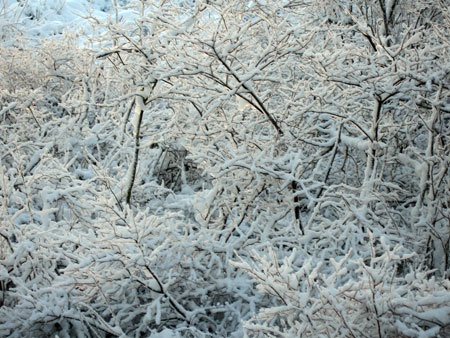




It’s snowing. A heavy wet snow. At first it seemed like it was going to turn to rain but now its big white flakes and the ground is covered with white. I had to drive home from Halifax this evening and all the cars, thankfully, were driving slowly. My favorite Canadian joke is still the one that says you know you are a Canadian when you prefer winter driving, it’s smoother, because the potholes are filled with snow. Out here in the woods, that will be something to look forward to, for sure.

I had an “interesting” phone call last Saturday. My art dealer in San Francisco has a client who is very interested in my work. That’s nice. But. This person wants to buy part of a triptych: the middle panel and one of the side panels. She will use the middle panel upright (as it is supposed to be) and then she wants to place the side panel on its side (and hang it over a coffee table, or something like that). I said no, of course. No. No amount of money is worth destroying the integrity of that painting. It happens to be one of my favorite pieces, something I feel very strongly about, and would never want to see it broken apart and turned inside out. Maybe it would look good to the buyer, but certainly not to me.
There’s a section titled “Canines at the Artist’s Easel” in Stanley Coren’s book The Intelligence of Dogs. He relates that in 2002, the National Arts Club in New York held an exhibition of a dog’s “paintings.” The works were actually collaborative, having twenty-six artists “finishing” a piece Tillie the dog had started or incorporating Tillie’s painting into a larger work. A professor from New York University gave Coren his appraisal of the artistic merit of the works: “The intent of the artist has little to do with whether the production is deemed to be art by those who look at it. It is simply the eye of the beholder that determines the artistic value.” And this man had his eye (and possibly/probably his affection and open wallet) on a particular painting.
That really speaks to the vicissitudes of the art market. To the instability, uncertainty of production. To the fickleness that plagues this precarious vocation. I would hope that my intentions in my paintings are respected. But I can never be sure.
Then later on Saturday a friend called to tell me she had received a newsletter from an artist in Vancouver saying in China there is a company pilfering painting images from websites. Unbeknownst to the artists, they are making inexpensive reproductions and selling them at a very low price, between about $16 and 46 ($U.S.). They also frame and ship. Quite a deal! They have about 2800 artists, about 800 from Canada. I happen to be one of them. Apparently Chinese copyright laws say this is legal until requested by the artist to remove their works from this process. But some artists have requested such and not been respected, yet.
Well, this does make the work visible. But I am not receiving any royalties. I know how musicians must feel about downloaders of free music. The music is being heard, but no royalties. And where’s the respect. And for all I know, my images are being turned sideways, upside down and inside out! Obviously we have some homework to do here.
PS: The newletter ends with: "The superior man understands what is right." (Confucius)
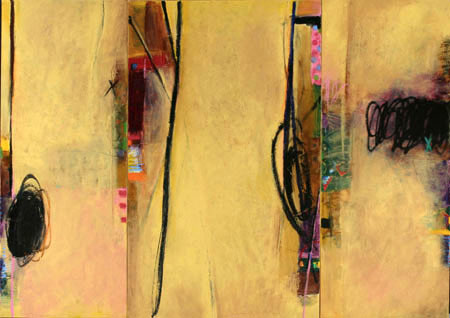
Tamar tagged me for this meme. Couldn’t resist. So here goes:
1.) I love books. Everything about them—the smell, the look, the feel, how they line up on the shelves, how they remind me of various times and events in my life (how this or that book reminds me of that juicy time!). It’s hard for me to let go of a book that means a lot to me, one I enjoyed, that brought me that certain kind of pleasure, one that is indescribable. My favorite time to read now is lying in bed at night and read, often for hours if it is a good book. It feels so luxurious.
2.)The fondest memories of summer in my teen years are lying in a canvas hammock in the back yard under big maple trees drinking lemonade and eating saltines all day and reading reading reading. The books I read then were the Romantic novels by the Bronte sisters, Thackery, Charles Dickens. I remember my sister laughing in the next room when she heard me crying at the end of Jane Eyre. She said she had done the same. Still.
3.)I read Kazantzakis’ Zorba the Greek while nursing Tamar in the middle of the night and started calling her Bubalina. Nobody but me seemed to know why. And maybe the love of reading seeped into the milk.
4.)I very rarely do not finish a book I’ve started. It has to be pretty bad for me to put it down! Often when I’m reading a book that doesn’t measure up (for me), I edit the writing in my mind. Rewrite a sentence, change a word, a structure. But I never tell the author.
5.)I used to flip to the end and also read passages before the end before reading the full book but I have tried to train myself out of that. It isn’t fair to the writer. Now I only do it occasionally, when either the book is too upsetting and I feel I can calm down reading it if I know the ending (hoping that it has a “good” ending) or it is so bad that I wouldn’t finish it unless I knew the ending.
6.)Libraries have been a refuge some of my life (especially during school years), a place or terror at others. Too many choices, too little time to read everything. I’ve just begun to make friends again with libraries. In fact, I look forward to going there just before my dance class (it’s right across the street) every Wednesday evening.
7.)My parents had beautiful leather bound books for the living room shelves. Dickens, Thackery, Homer, Aristotle. I loved to pick them up, smell them, and read them. They made our living room special. I’ve always arranged my books on the shelves by authors (not size or date), grouping authors who write a certain type of book together, keeping a modicum of order on my shelves.
8.)I’ve always thought of myself as a slow reader. Probably because I savor every word. The few times that I have skipped a word, I find I need to go back and get it right. (It’s only respectful, after all!)
9.)I feel naked without a book to read. It’s almost a feeling of panic if there is not a book lined up to be read. I have some good reader friends and we pass books back and forth. Three of us have set up a library in Inge’s house. We have all contributed books, but I must admit, I keep my favorites home, just in case I NEED them (and sometimes I really do!).
10.)I used to read all of one author, not move on until I had exhausted their writings. But now it feels like there is so much to read, I am more extravagant, taste a smorgasbord of books.
11.)I love a good short story collection. I love a good, long, intense involved novel. I’ve never been good with mysteries or science fiction, yet I have read some (mysteries maybe) by better writers and not thought about them as a type. They were just good. When a book doesn’t come across as a particular genre, but has merit for the writing and ideas, then it doesn’t matter to me where it fits, what type it is. I guess I’m not much for light reading, though. When I feel that need, short stories do the job very well.
12.)My taste runs mostly to novels that portray some kind of understanding that enriches my life in some way. Recently, I really was enchanted by The Dive from Clausen’s Pier (which I lent to a friend and she said it renewed her faith in contemporary literature). I also loved The Kite Runner and Light on Snow. I wouldn’t change a word in any of those books.
13.)I read novels easily, and magazines sometimes, but a newspaper is beyond my grasp. Maybe it is the print being so small, but more likely it is the news itself. Having grown up during World War II (and just being who I am), newspapers are difficult for me. Maybe too it is the feeling of holding a book. It just feels so good.
14.)My parents had a great respect for reading. My mother loved the New Yorker, read it cover to cover as soon as it arrived. But I don’t remember her reading books other than cookbooks. My dad read lots of novels, often historical novels, right up until he died at 90. I can picture him at any age sitting in a comfortable chair with a book on his lap.
15.)My mother taught me to read before I learned at school. She didn’t try. It just happened. I was standing in the back of our 1937 black Plymouth sedan, in the early 1940’s, while my mother helped me figure out the words phonetically on the way home from buying the reader, a Dick and Jane book. The teacher then called my mother in and scolded her in front of me. It probably left some scars but I am not sure where they are. I know I stopped caring for that teacher, was glad when I went into the next grade.
This was great! I could keep going but now I will tag Elin, Rachel, and Jessica. Have fun kids!
It snowed a little last night. Our first snow of the season. Last year at this time we were buried under, piles four feet high, without power for a week. This snow was light, just a dusting. I’m not eager for winter to arrive, but I must admit it is very pretty.
A couple of weeks ago, after coming out of the magnificent, overwhelmingly beautiful and deeply moving dance performance by Compagnie Marie Chouinard, in which the dancers used metal crutches and walkers as part of their dance, my friend who accompanied me asked: “Do you think someone who had a real disability would be offended by this dance?”
Quite possibly. It would depend on the person’s relationship to their disability. Some people are comfortable with their handicaps. Some people wear their illnesses and handicaps as a badge. To others, it is such an insult that the relationship is more of anger or shame. But the dance itself elevated the possibilities of human bodies, realigned the misuse, disuse, abuse of limbs to a level of unlimited beauty.
In A Million Little Pieces, James Frey quotes a Taoist saying that helped him through his difficult times recovering from addictions:
If you want to be whole, you must first be partial. If you want to be straight, you must first be crooked. If you want to be full, first become empty. If you want to be reborn, you must first die. If you want everything give everything up. If you don’t display yourself, people will see your light. If you have nothing to prove, people will trust you. If you don’t try to be something, people will see themselves in you. If you don’t have a goal, you will always succeed.
The first dancers came on the stage with one toe shoe on one foot, the other foot bare. And hobbled across the stage. At another time, toe shoes were on the hands as well, a four foot walk on point. Or dancers scooted across the stage leaning into a walker. And all with magnificent grace, displaying love for the human body in all its manifestations. If we could only feel that within ourselves every day, there would be no more prejudice. Life would be quite fine.
It was snowing when I arrived in Montreal last Thursday. I stayed at the window half the day taking photos.
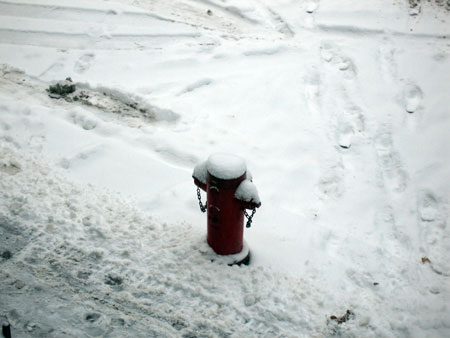
The classic steep outdoor steps of Montreal. The day I left they were covered with a sheet of (thick) ice. Aaron helped me down with my suitcase.
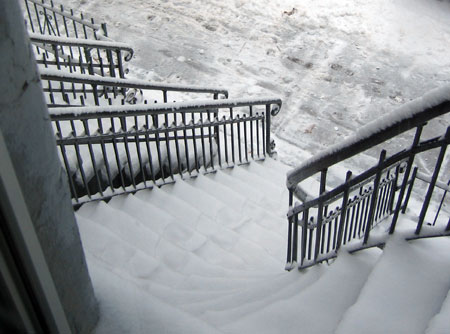
Jessica pointed out a pear tree a tree in their back yard. She had watched as the leaves fell, leaving a single pear.
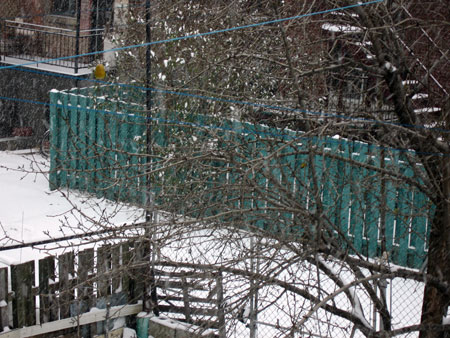
Their adorable four month old kitten, Mr. Higgins, is very playful.
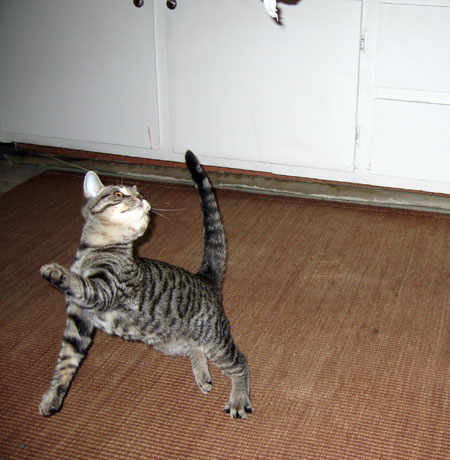
He enjoys chasing his tail around the rungs of the chair I nursed Aaron in thirty-eight years ago. Aaron's daughter Shaya was also nurtured in this chair. Mr. Higgins has a different idea for the use of this chair!
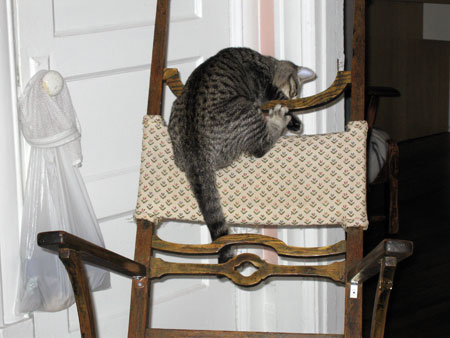
New research shows that, just like mothers always knew, wet cold feet can lead to a head cold. My trip to Montreal was really great, had a wonderful time, but it was freezing cold, snowed, and my boots leaked. Walking around Montreal with cold and wet feet did the job.